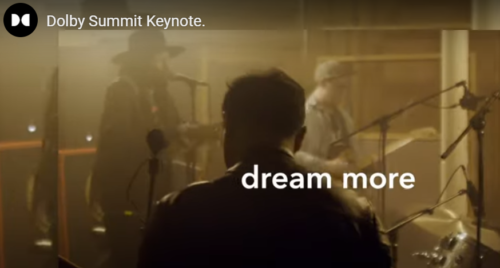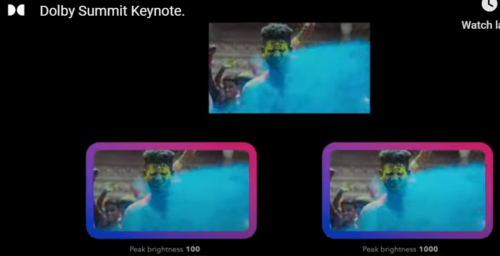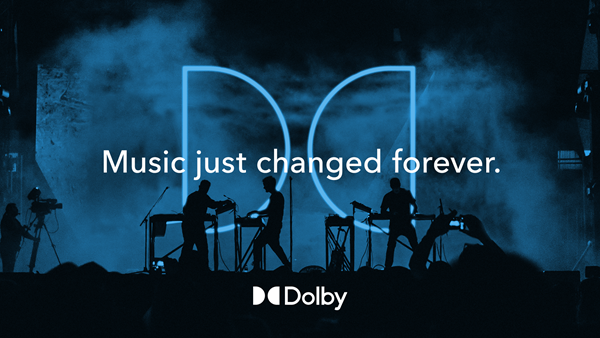M+E Connections

Dolby Vision, Atmos and More Touted During Online Dolby Summit
Story Highlights
Dolby Atmos and Dolby Vision adoption continues to grow and has even been given a boost when it comes to home and mobile device applications, the company said during the online Dolby Summit Oct. 29.
The COVID-19 pandemic “has changed how our industry comes together,” according to John Couling, SVP of commercial partnerships at Dolby, who noted the event was the “first real-time digital conference experience enabled with” Dolby Vision and Dolby Atmos.
“Dolby technology is a gateway [that] allows artists to go deeper into the creative process,” he told viewers at the start of the keynote that kicked off the event. “It allows audiences to explore new worlds. It allows all of us to connect with each other across time and space,” he said.
Because of the pandemic, “this year – and I think it’s true for all of us – bringing people together for shared experiences has taken on a sense of urgency,” he pointed out. “And it’s true for Dolby as well because, let’s face it, this is a moment when – well, at least here in the U.S. – many of us are feeling disconnected,” he said.
So “it’s understandable that the demand for new content, therefore, is skyrocketing,” he told viewers.
 “Dolby technology is more accessible than ever” now and more creators working across all media are increasingly learning how to use Dolby Atmos and Dolby Vision, he noted. Audiences and creators can now capture, edit, watch and share videos in Dolby Vision exclusively on the full line of new Apple iPhone 12 smartphones and a growing number of creators want to work with Dolby, he said.
“Dolby technology is more accessible than ever” now and more creators working across all media are increasingly learning how to use Dolby Atmos and Dolby Vision, he noted. Audiences and creators can now capture, edit, watch and share videos in Dolby Vision exclusively on the full line of new Apple iPhone 12 smartphones and a growing number of creators want to work with Dolby, he said.
These trends are “setting off an explosion of content,” he told viewers. “On the supply side, service providers are leveraging the growing ecosystem that delivers content in Dolby” and audiences globally are experiencing this content “at home and on the go, and on all kinds of devices,” he pointed out.
A whopping 99 percent of global audiences can now access a service with content enhanced by Dolby Vision and Dolby Atmos, according to the company, which has multiple broadcast and streaming service partners and “we’re continuing to grow our reach,” Couling said.
Meanwhile, Dolby audio and imaging technologies are “included in the broadcast standards” around the world, he noted.
Digital content has become a “source of shared experiences, especially with so many of us staying home” during the pandemic, he told viewers. As an example, he pointed to the video version of the hit Broadway show “Hamilton,” which was made available on Disney Plus in 4K Dolby Vision high dynamic range (HDR) and Dolby Atmos sound. After its release on the Disney streaming service, downloads of the Disney Plus app surged by nearly 75%, he said.
Dolby Vision Specifics
Providing a more in-depth look at Dolby Vision, Lindsay Cookson, VP of 360 marketing at Dolby, told content creators watching that the technology “enables the best possible version of your film or TV show, preserving how you wanted it to look on whatever device the viewer is watching it from.”
To achieve that, she explained: “Dolby Vision allows for the creation of trims for each shot to control how content maps to a range of devices. It then adapts to deliver the best possible image to that device. And because Dolby Vision maintains the full dynamic range of the image, the video will still map correctly and look even better in the future, as consumer TVs and entertainment devices improve and deliver greater dynamic range.”
Echoing Couling, she told viewers: “The desire for better premium living room entertainment experiences has only grown with more people spending time at home.” Citing the results of a recent survey conducted by Dolby, she said 49% of respondents reported they planned to upgrade their streaming service to enhance their experiences, while 76% of them were considering buying a TV, home theatre or streaming device for the same reason. “People want to invest in a better experience,” she said.
 Boosting Studio’s Back Catalogs
Boosting Studio’s Back Catalogs
That desire doesn’t just apply when it comes to new video content, but library content also, so there is value in upgrading back catalogue titles, Cookson noted.
For example, StudioCanal has started rereleasing titles in its film catalogue in Ultra High-Definition (UHD) Blu-ray with Dolby Vision, including the classic Jean-Luc Godard French film “Breathless,” David Lynch’s “The Elephant Man” and John Carpenter films including “The Fog” and “Escape From New York.” By releasing these titles on UHD Blu-ray with Dolby Vision, StudioCanal is not just making consumers buy the same movie again just for a new cover, according to Jean-Pierre Boiget, head of distribution services at that company. “It allows them to really enjoy something new,” he noted.
There are now more than 4,500 movies and TV show episodes available in Dolby Vision, according to Cookson, who predicted “the use of Dolby Atmos will only increase as more creatives experiment and have fun with this new sound palette.”
And what helps is that “working in Dolby Atmos is not that complicated or costly,” she pointed out. “It’s actually built into the tools you use now and when you mix in a Dolby Atmos-first workflow, you can drive the stereo and 5.1 mixes, avoiding having to do separate projects and increasing your efficiency,” she said.
Again citing results from Dolby’s recent survey, she said 69% of respondents said the availability of Dolby Atmos and/or Dolby Vision would be “important” or “very important” when choosing a new video streaming service.
Dolby Atmos Music Momentum Also Continues
There has, meanwhile, also been “tremendous momentum” for Dolby in music, Cookson said.
Dolby Atmos Music is now supported by Dolby partners including Warner Music, Universal Music and independent labels and distributors, Christine Thomas, senior director of music partnerships at Dolby, pointed out.
Also fuelling Dolby Atmos Music growth is the company’s partnership with Avid Technology on the AvidPlay self-service distribution platform, Thomas said, adding: “AvidPlay is just the beginning. There are more to come.”
 Whether talking about movie or music studios, meanwhile, there are “hundreds of professional rooms around the world mixing and producing Dolby Atmos, with more coming on board every day,” she added.
Whether talking about movie or music studios, meanwhile, there are “hundreds of professional rooms around the world mixing and producing Dolby Atmos, with more coming on board every day,” she added.
Dolby Technologies in Live Sports
Dolby Atmos is being increasingly used to enhance live sports programming, according to Mahesh Balakrishnan, VP of audio business at Dolby, who noted NBC has made select events at the Olympics available in Dolby Atmos since 2016.
In Europe, Dolby partners including Sky Sports and BT Sport have been broadcasting in Dolby Atmos since 2017, including FIFA Soccer, he noted, pointing out: “Sky Sports alone delivers over 250 live events in Dolby Atmos each year.”
Mike Davies, SVP, technical and field operations at Fox Sports and chairman of Sports Video Group, went on to tout the benefits of HDR. Although the technology stands to enhance all content, “some productions benefit more from HDR” than others, he said. That’s why Fox Sports has been heavily supporting football and NASCAR in HDR, he told viewers, pointing to how much it helps enhance colours and replays, which he said “are really important.” HDR, however, “definitely raises the bar for all productions,” he added.
Dolby AC-4 Update
Moving on to provide an update on Dolby AC-4, Balakrishnan said it has become the “next-generation audio codec of choice for many broadcasters” globally.
It’s now supported in over 25 TV around the world, on 15 device brands on more than 115 million devices in the market, and there are now 10 live series and trials on the air, he said.
AC-4 is featured in over 80% of all UHD TVs shipping in Europe from manufacturers including LG, Panasonic, Philips, Samsung and Sony, he noted.









